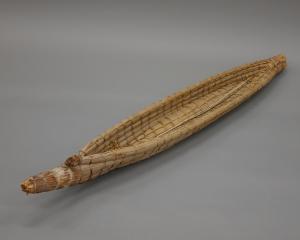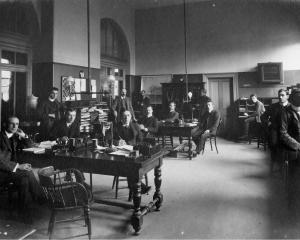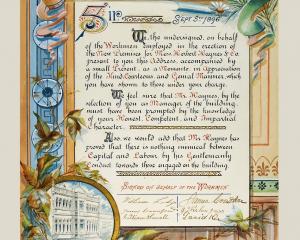
Two events prompted me to think about the works at the Forrester Gallery with which I have "fallen in love".
These events are my impending absence from my role for 12 months and a talk I gave to the Friends of the Forrester members on Valentine’s Day.

For me, falling in love with art happens when a work stops me dead in my tracks and demands I remain engaged. The work imprints so that I can recall it in minute detail years later. I can remember the emotions I felt, and I will always try to find the work again.
Firstly, there are the works that make you think. Not all works that resonate are conventionally "beautiful", or about lovely things. Peter Cleverley’s work Couriers (1986) is one such work. I first saw it in person when preparing for his show Zeitgeist: Works by Peter Cleverley. In the end, we didn’t include it in the exhibition, but I still had to know more. I hadn’t been born when the events that prompted him to create the work occurred, but while researching and writing for his exhibition, I nevertheless went down a rabbit hole to discover what happened to the work’s two figures, Lorraine and Aaron Cohen. The mother and son New Zealanders were arrested for heroin trafficking in Malaysia in 1984.
I love what the work has taught me, and how it makes my brain want to know more.
Secondly, there are works by an artist I’ve become fixated on - in this case, the works held at the Forrester by Annie Baird. Through the process of researching, I end up developing a connection with the topic. A collection mystery that came to light while preparing for an exhibition meant I invested more time and energy into her work.
This - alongside my enjoyment of her style and use of colour, that she is a female artist (a bias of mine) and that much of her work features Dunedin, my hometown — all added to my love of her work.
Thirdly, is the work in your favourite genre. For me that is portraiture; in particular Pat Hanly’s work Girl on Couch (1973). There is something about portraiture — the way an artist can capture their subject and communicate so much about the person through a single static image. Pat Hanly’s work isn’t conventional. It doesn’t show its subject’s face. However, Hanly used colour, line and contrast to communicate aspects of his subject.
And, finally, there are the works you just like. As a curator, when you move from one workplace and collection to another, your attention is often grabbed by objects in your new place of work that remind you of your last place. Something familiar among the unfamiliar.
Theo Schoon’s untitled incised gourd from our collection is one of those works. It is a wonderfully substantial object - not heavy, but it takes up space. It makes you want to see it from all angles and to touch the carved shapes. The gourd also connects me to one of my first "real" jobs in the sector, because Schoon was part of my artistic landscape in my first museum role.
There is no right or wrong to loving a piece of art; just enjoy being connected to it.
Imogen Stockwell is curator visual arts at Forrester Gallery, Oamaru.












